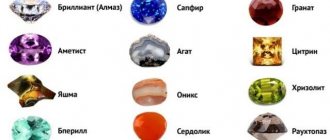Why do “owners” mark people with tattoos and piercings?
Today tattoos are becoming increasingly popular. If 20-30 years ago tattoos were more common among representatives of criminal structures and partly the military, today tattoos can be seen even on teenagers.
Interestingly, in the Middle Ages, tattoos were applied to convicted criminals forcibly. This was a kind of brand, so that a person who broke the law would have such a mark for the rest of his life, and those around him would know who they were dealing with. Why did people start branding themselves?
Surprisingly, if in the past criminals tried in every possible way to avoid applying the mark, and after applying it, they tried to reduce or disguise it using various methods, then after several centuries the situation changed exactly the opposite - first the same criminals, and then ordinary social people began to “brand” themselves.
We should also consider tattoos, which are common in criminal and near-criminal environments. Contrary to popular misconception, these are not just beautiful drawings; you can read a person’s entire biography from tattoos or, as they are called, “tattoos.”
For example, a conviction for a particular type of crime is marked in the form of a corresponding tattoo and makes it possible to determine for what crimes the person was convicted. That is, we are dealing with the same medieval method of branding, only now criminals began to do it voluntarily, and even moreover, it became a kind of fashionable trend in that environment. Why did it happen?
This is a vivid example of unstructured management of society, when violence is committed not directly, but in a veiled way - through influence through consciousness. Agree, it is much easier to convince a certain group of people that branding oneself is fashionable, cool, and so on, than to maintain an entire service that will specifically monitor the process of applying the corresponding brand. As old as the world - the best slave is the one who does not suspect that he is a slave.
Brand fashion
If the process of branding criminals is understandable, then where did the fashion for branding come from among ordinary people who are sometimes not at all associated with crime? This question, perhaps, should be considered from an esoteric point of view. Egregorial-matrix management of society involves “connecting” people to certain egregors through images or thought forms.
Branding is a long-standing tradition that simplified the process of slave management and control over criminals. But if in ancient times applying a brand was a symbol of slavery and humiliation, today it is a symbol of a “free” person who supposedly demonstrates his individuality in this way.
The fact that today almost every fifth person is “pinned” with images of some kind of animals or skulls, and no individuality can be traced here, no longer worries anyone. But if you consciously approach this issue, it becomes quite obvious that this trend did not appear on its own. It was deliberately imposed on us by the same slave owners, who only changed their appearance to a more benign one, and the scheme of slavery itself became more civilized - now the whip and shackles are replaced by the media, or more precisely, by the media of disinformation.
How we are taught to brand ourselves
The introduction of certain trends and behavior patterns into society is quite simple. It is necessary to spread the desired model of behavior among public people who are the idols of millions. A striking example of such an influence on the masses through idols can be the facts that the famous Hitler mustache was very popular among German soldiers during the Second World War. Moreover, the most curious thing is that this was often done even unconsciously.
Today, of course, it is difficult to find such odious and influential leaders - the idols today have become considerably smaller, but this does not change the essence of the matter. Pay attention to the so-called “rappers” - performers of specific youth music. By the way, it is possible that this direction in music (if it can be classified as music at all) and the corresponding subculture were also created intentionally - to control the masses. These are the basics of psychology: the teenage psyche reacts very sharply to everything bright, loud, daring and, as they say now, “shocking.” And this is exactly what the rapper subculture gives young people.
So, pay attention to rappers - their bodies in most cases are completely covered in tattoos. Is this a coincidence? Hardly. Those who are interested in promoting the fashion for voluntary branding are well aware of the authority these, so to speak, “performers” have. However, they really are performers, not of music, but of the will of slave owners, who, through rappers, promote the fashion for voluntary branding.
What are the dangers of tattoos and piercings?
First, let's return to ancient history, where the phenomenon of a tattoo, or, to call a spade a spade, a brand, originates. Those who like to paint their bodies will be interested to know that the first bearers of “tattoos” were... cattle. Yes, exactly cattle. Owners or shepherds branded their animals to distinguish them from each other.
There is also interesting news for piercing lovers. The first “fashionistas” in this area were... bulls. To make it easier to manage and control the bull, a ring was put in its nose, a rope was tied to the ring, and now it could be easily controlled or simply tied to a pole. Probably, if at that time they had come up with the same thing for people, few people would have liked it, but today they also pay money to insert a ring into their nose.
Then the fashion for tattoos began to spread to people - criminals and prostitutes began to be branded. Many people remember the story of the “three musketeers”. There, the owner of a “beautiful” tattoo in the form of a lily was... a thief. It was with this symbol that thieves were branded in France. So this is a reason to think for those who already have a tattoo in the form of this beautiful flower or are planning to get such a decoration on themselves.
Thus, just a few centuries ago, tattooing was the preserve of marginal elements of society. She was a symbol of shame, humiliation and a parasitic lifestyle. Those with tattoos were shunned like lepers. Just as a person with leprosy was forced to wear a bell, so criminals and outcasts were marked with a shameful mark. And just as at the sound of a bell people ran away in fear, they also looked with disgust at the wearer of such “decoration”.
And today they pay money for such jewelry. Thus, we are dealing with a typical “Overton window”, when the attitude towards any phenomenon completely changes in society to the opposite. And this does not happen by chance. This happens deliberately, deliberately, purposefully and with the investment of considerable funds to promote a particular trend in society.
What is the danger of tattoos? Applying a brand is one of the main tools of egregorial-matrix management. Let's remember the example with cattle, for what purpose did the owner brand the animals? Probably not so that his sheep would be beautiful fashionistas, but to show that “this is my property.” And today the meaning of a tattoo is the same - the application of certain images puts a mark on a person, at the energetic and psychological level turning such a person into the property of the energy structure to which the symbol is related.
It's funny, but even in order to brand an unfortunate sheep, you need to involve at least two people who will spend at least several tens of minutes to catch this sheep, fix it and apply the brand. Paradoxically, it is much easier to control people - they themselves come to establishments to apply a brand, do not resist, and even pay money for it. What can I say, the poor branded sheep are laughing quietly.
The history of the use of tattoos clearly shows us that applying a mark has always meant a decrease in status for a person. The stigma was applied to slaves, criminals and marginal elements. And only with the help of the media did slave owners manage to teach slaves to brand themselves.
The second harmful factor is the energetic aspect of tattooing. A tattoo on a person’s body always introduces an imbalance into a person’s energy. Notice which images are the most popular? Most often these are symbols of death, violence, and a suicidal lifestyle. Skulls, bones, knives, brass knuckles, images of wild animals with grins, images of a razor, a syringe, and so on.
Social studies conducted in juvenile colonies showed that those convicts who had tattooed themselves from their first conviction, in almost one hundred percent of cases, further connected their lives with the criminal world and returned to prison again. Thus, applying a tattoo is a kind of programming on the subconscious and energetic level.
One can, of course, argue that they threw out the baby with the bathwater. Skulls, of course, should not be “pricked”, but some positive images, on the contrary, will be “amulets”, and in general will contribute almost to spiritual development. However, this, alas, is a misconception. Pay attention to the prison “tattoos” - there are often images of Christ, churches with domes, angels, stars.
Most criminal authorities are painted from head to toe with religious symbols. However, for some reason this does not add spirituality to them. It is quite obvious that the system of branding and programming fate and consciousness through images on the body works somewhat differently. And how reasonable is it to put images on our body of the true meanings, meanings and effects of which we do not even suspect?
By the way, an interesting fact - the fashion for tattoos in the form of the crucifixion of Christ and similar ones came from English sailors who, being completely inveterate criminals, gave themselves such tattoos in the hope that in the event of a sentence of corporal punishment, the executioner would not raise his hand to the image Christ.
Soviet criminals who painted themselves with images of Lenin and Stalin were also subject to the same myth. They believed that when trying to escape, the guard would not risk shooting at the image of the leader. However, as a rule, no one’s hand trembled. They shot, received a well-deserved ten days of leave, and their conscience did not torment them. Because “domes” on the body do not yet make a person a saint.
Another interesting news for piercing wearers. In the harems of the Turkish sultans, all wives were forced to have their navel pierced. It was believed that this procedure completely breaks the woman’s will, and after that she will fulfill all the dirtiest desires of her owner.
There is an opinion that the owners of transnational corporations that rule the world today have deep knowledge of esoteric and mystical teachings. And all trends and patterns of behavior that are imposed in society have a deep meaning and are aimed at enslaving a person and changing his consciousness.
At least in the case of tattoos, the situation is quite obvious. Branding is a type of punishment, it is a shame, a symbol of slavery and humiliation of human dignity, and in no way a manifestation of some mythical “individuality.” An attempt to stand out by disfiguring one’s body is precisely a sign of infantility, underdevelopment and lack of self-sufficiency of the individual. An attempt to attract attention with piercings or tattoos is a cry of despair of an empty person who has nothing else to attract the attention of others.
However, if the fashion for disfiguring one’s body develops at the current pace, then in 10-15 years it will be possible to attract attention to oneself with clean, healthy skin, and not covered with brands, rings and God knows what else.
“There is no saint without a past, there is no sinner without a future” - this proverb says that everything can be corrected. We live in a world that is subject to the law of cause and effect. And even if in the past, out of stupidity, a person was fond of tattoos and piercings, this does not mean that this cannot be corrected. In order to eliminate the consequences of unreasonable actions, you need to create a reason for this.
What to do if you already have a tattoo
First of all, it is recommended, if possible, to get rid of a tattoo or piercing in order to at least eliminate the cause for further problems with your energy, consciousness and life in general. To further correct the situation, there is such a tool as yoga - a system of spiritual development. In addition to various methods of working directly with your consciousness, in yoga there is a special section of practices called “shatkarmas” - these are practices that cleanse the body and consciousness. There are six of them in total. Actually, “shatkarma” is translated as “six actions”.
Mantras can probably be called a universal means of cleansing the body and consciousness. They do not require serious physical training, as in the case of hatha yoga (although to practice mantras it is desirable to be able to sit cross-legged for at least about 30 minutes), nevertheless, they are a powerful tool for cleansing and spiritual development.
But the most important tool and the most powerful weapon is, of course, a conscious life filled with altruistic motivations. If your activities are aimed at changing the world around you for the better, or at least you are already striving for this, the consequences of past mistakes will disappear like morning fog. And the sun of new life will shine above your head.
What is a spool test?
Zolotnik is a measure of weight in Rus', equal to 1/96 of a pound (1 Russian pound is approximately equal to 0.4 kg). Until 1927, when the metric system was introduced, the spool system was officially used to determine the amount of impurities in precious metals.
Until now, in antique stores and pawn shops you can sometimes find products made of precious metals with a spool hallmark - a two-digit digital designation that can easily be converted to the modern metric system. To do this, you need to use a simple formula: X/96*1000, where X is the value of the spool test.
For example, 72/96*1000 = 750. So, 72 spool test corresponds to 750 metric sample.
The spool sampling system appeared in 1711 during Peter’s reforms and existed in Russia for more than 200 years, until Soviet times.











